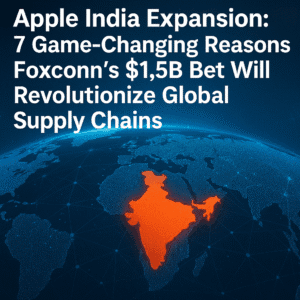Apple India Expansion: 7 Game-Changing Reasons Foxconn’s $1.5B Bet Will Revolutionize Global Supply Chains
Apple is deepening its manufacturing footprint in India as key supplier Foxconn invests $1.5 billion to build a display module plant in Tamil Nadu, advancing efforts to diversify beyond China. The facility, set to generate 14,000 jobs, underscores India’s rising role in Apple’s strategy to mitigate geopolitical risks and supply chain vulnerabilities exposed during the pandemic. While India accounted for 18% of global iPhone output in 2024—projected to hit 32% by 2025—the move clashes with Donald Trump’s demands to reshore U.S. manufacturing.
Despite political pressure, Apple’s pivot reflects pragmatism: China still dominates production, but India’s cost efficiency and policy incentives (like production-linked subsidies) offer scalable alternatives. Challenges persist, including infrastructure gaps and reliance on imported components, yet Foxconn’s commitment signals confidence in India’s potential to evolve into a tech manufacturing hub. This shift highlights a broader industry trend toward “China+1” strategies, balancing geopolitical tensions with economic realities. For Apple, the gamble hinges on India’s ability to bridge logistical and technical divides while navigating an increasingly fragmented global trade landscape.

Apple India Expansion: 7 Game-Changing Reasons Foxconn’s $1.5B Bet Will Revolutionize Global Supply Chains
As geopolitical tensions and pandemic-driven disruptions reshape global manufacturing, Apple is accelerating its supply chain diversification with a landmark $1.5 billion investment by Foxconn in Tamil Nadu, India. This move underscores a deliberate shift away from China, despite former U.S. President Donald Trump’s push to repatriate production to American soil. Here’s a deeper look at the implications, challenges, and broader trends driving this transformation.
Foxconn’s Display Plant: A Milestone for India’s Tech Ambitions
The new facility near Chennai will focus on producing display modules for iPhones—a critical component beneath the screen that manages touch responsiveness and display quality. Slated to create 14,000 jobs, this project aligns with India’s “Make in India” initiative, which has lured global manufacturers with production-linked incentives (PLIs) worth billions. Tamil Nadu, already a hub for iPhone assembly, solidifies its role as India’s answer to Shenzhen, China’s manufacturing powerhouse.
By the Numbers:
- India contributed 18% of global iPhone production in 2024, projected to rise to 32% by 2025 (Counterpoint Research).
- Apple aims to source all U.S.-bound iPhones (60 million units annually) from India by 2025.
The Geopolitical Tightrope: Trump’s Critique vs. China’s Dominance
While Apple’s pivot to India is driven by cost efficiency and risk mitigation, it faces political headwinds. Trump recently lambasted the company for expanding abroad, demanding a return of manufacturing jobs to the U.S. However, reshoring remains impractical due to higher labor costs and a lack of specialized infrastructure. Meanwhile, China still accounts for over 60% of iPhone production, highlighting Apple’s reliance on a delicate balance between diversification and dependency.
India’s Rise as a Manufacturing Powerhouse
India’s appeal lies in its vast domestic market (the world’s second-largest smartphone buyer), competitive labor costs, and proactive policy reforms. The PLI scheme, offering subsidies tied to production volumes, has attracted giants like Foxconn, Tata Electronics, and Pegatron. Yet challenges persist:
- Infrastructure Gaps: Reliable power, logistics networks, and port efficiency lag behind China.
- Skill Development: Technical training programs are critical to meet Apple’s precision manufacturing standards.
- Supply Chain Localization: While display modules mark progress, India still imports high-value components like semiconductors and sensors.
Broader Industry Trends
Apple isn’t alone in diversifying. Samsung, Google, and Microsoft are also expanding in Vietnam, India, and Mexico. This “China+1” strategy mitigates risks but complicates logistics. For India, replicating China’s ecosystem of suppliers, ports, and rapid prototyping capabilities will take years—yet the momentum is undeniable.
The Road Ahead
Foxconn’s investment signals confidence in India’s potential, but success hinges on addressing systemic hurdles. For Apple, the stakes are high: balancing cost savings, quality control, and geopolitical pressures while navigating Trump’s rhetoric. As U.S.-China tensions simmer, India’s role as a neutral, scalable base could redefine global tech manufacturing—if it delivers on its promise.
Apple’s India expansion is more than a logistical shift—it’s a strategic realignment with ripple effects across geopolitics, local economies, and global trade. While challenges remain, the move reflects a pragmatic response to an increasingly fragmented world, where agility and diversification are the new imperatives.
You must be logged in to post a comment.